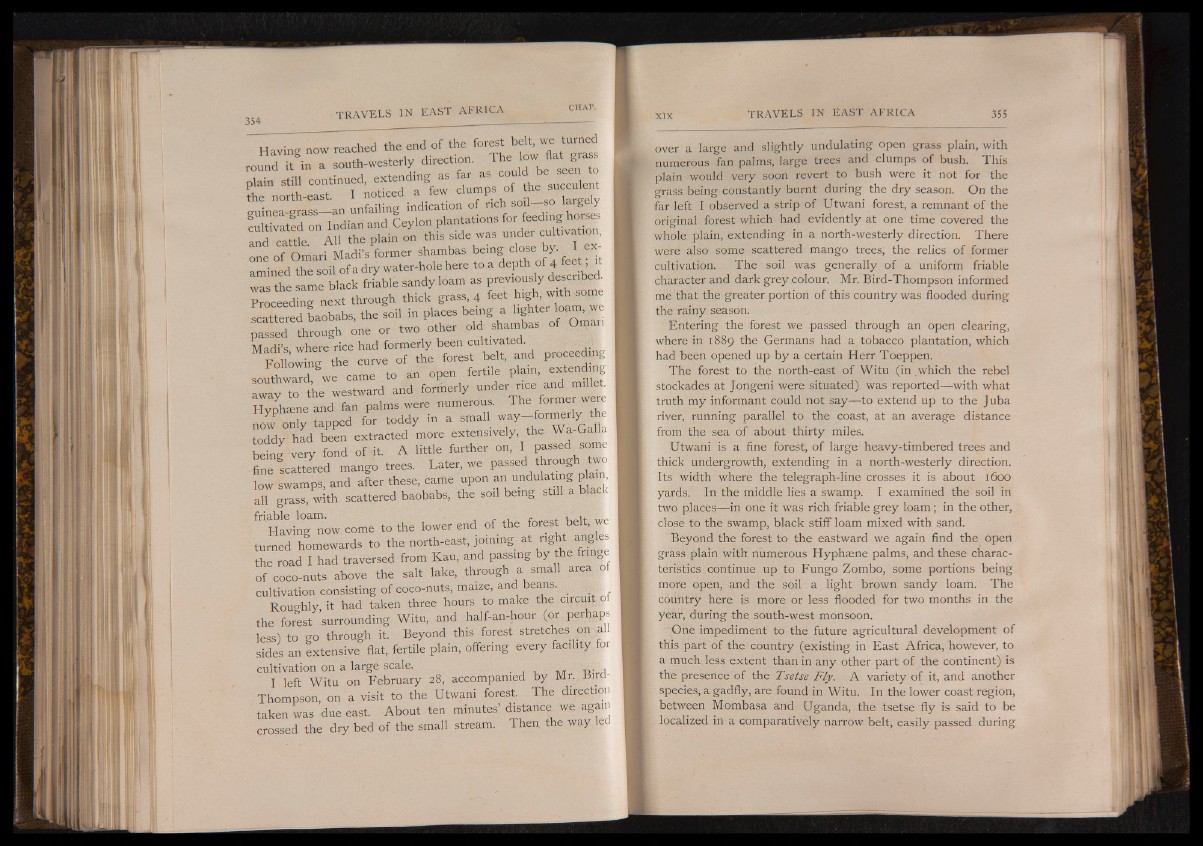
Having now reached the end of the forest belt, w e turned
round it in a south-westerly direction. The low- m ^ s
plain still continued, extending as far as could be, M^
the north-east I noticed a few clumps of the succulent
^ „ « i a i i a n unfailing indication of
cultivated on Indian and g ^ j f e f lan a t.d n s fo r .fe^ n g ^
and cattle All the plain on this side was under cultivation,
“ e of Omari Madi's former shambas being # ¿ 1
amined the soil of a dry water-hole here to a depth of 4 fe et» t
was the same black friable sandy loam as P ^ o u r iy
Proceeding next through thick grass, 4 feet high, with soipe
T c X e d lo b a b s , the soil in places being a b g « “
passed through one or two other .old shambas of Oman
Madi’s where rice had formerly been cultivated. |
the curve of the forest b * and p r« e e d ,g
southward we came to an open fertile plain, extend^ g
away to the westward and forAerly
Hvohsene and fan palms were numerous. The former were
1 taooed for toddy in a small now only tapped iui . way—, formWear.liyT qtlhlae
toddy had been extracted more extensively, the Wa-Galla
being very fond of it. A little further on, g passed some
fine scattered mango trees. Later, we passe t roug w
low swamps, and after these, came upon an undulating pla ,
all grass, with scattered baobabs, the soil bemg still a black
frl H ivin g now come to the lower end of the forest belt, we
turned homewards to the north-east, joining at right ang I
the road I had traversed from Kau, and passing y #
of coco-nuts above the salt lake, through a small area of
cultivation consisting of coco-nuts, maize, and beans. I .
Roughly, it had taken three hours to make the circui
the forest surrounding Witu, and half-an-hour (or perhaps
less) to go through it. Beyond this forest stretches onfall
sides an extensive flat, fertile plain, offering every facilityJor
cultivation on a large scale. -
I left Witu on February 28, accompanied by Mr.Bird-
Thompson, on a visit to the Utwani forest. The direction
taken was due east. About ten minutes’ distance we again
crossed the dry bed of the small stream. Then the w a y ^
over a large and slightly undulating open grass plain, with
numerous fan palms, large trees and clumps of bush. This
plain would very soon revert to bush were it not for the
grass being constantly burnt during the dry season. On the
far left I observed a strip of Utwani forest, a remnant of the
original forest which had evidently at one time covered the
whole plain, extending in a north-westerly direction. There
were also some scattered mango trees, the relics of former
cultivation. The soil was generally of a uniform friable
character and dark grey colour. Mr. Bird-Thompson informed
me that the greater portion of this country was flooded during
the rainy season.
Entering the forest we passed through an open clearing,
where in 1889 the Germans had a tobacco plantation, which
had been opened up by a certain Herr Toeppen.
The forest to the north-east of Witu (in which the rebel
stockades at Jongeni were situated) was reported— with what
truth my informant could not say— to extend up to the Juba
river, running parallel to the coast, at an average distance
from the sea of about thirty miles.
Utwani is a fine forest, of large heavy-timbered trees and
thick undergrowth, extending in a north-westerly direction.
Its width where the telegraph-line crosses it is about 1600
yards. In the middle lies a swamp. I examined the soil in
two places— in one it was rich friable grey loam; in the other,
close to the swamp, black stiff loam mixed with sand.
Beyond the forest to the eastward we again find the open
grass plain with numerous Hyphsene palms, and these characteristics
continue up to Fungo Zombo, some portions being
more open, and the soil a light brown sandy loam. The
cduntry here is more or less flooded for two months in the
year, during the south-west monsoon.
One impediment to the future agricultural development of
this part of the country (existing in East Africa, however, to
a much less extent than in any other part of the continent) is
the presence of the Tsetse Fly. A variety of it, and another
species, a gadfly, are found in Witu. In the lower coast region,
between Mombasa and Uganda, the tsetse fly is said to be
localized in a comparatively narrow belt, easily passed during